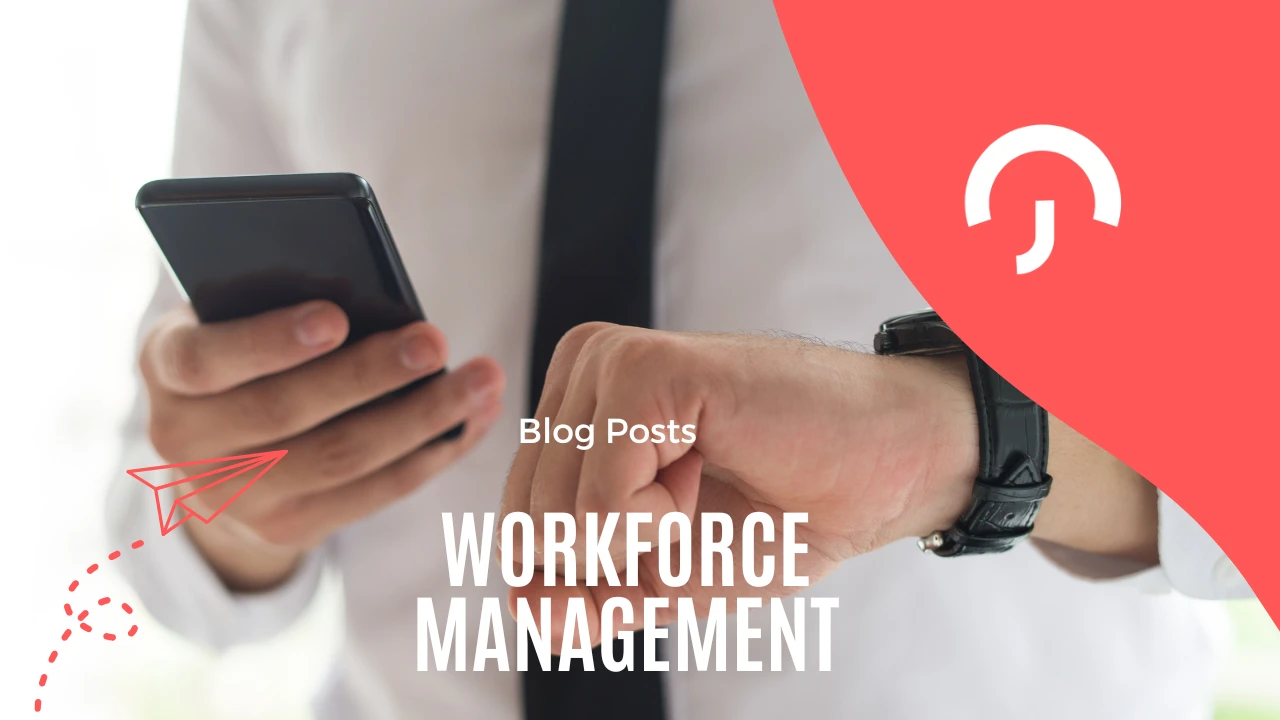Table of Contents
ToggleA time clock app is a digital workforce management solution that modernizes how businesses track employee work hours. Rather than relying on outdated punch cards, spreadsheets, or manual entry, a time clock app enables staff to clock in and out via smartphones, desktop browsers, kiosks, or even wearable devices. These apps log each action, start and end times, breaks, PTO, and store the data in a centralized, cloud-based system.
Advanced features like geolocation, biometric validation, and real-time reporting help businesses minimize time fraud, ensure accurate pay, and stay compliant with labor regulations. Many apps also integrate directly with payroll and HR platforms, streamlining administration and improving data accuracy.
Why Your Business Needs a Time Clock App
Adopting a time clock app isn’t just a tech upgrade, it’s a strategic move. Here’s why it matters:
Accuracy in Time Tracking: Digital clock-ins minimize manual errors and reduce the risk of time theft. Employees are held accountable for their hours, and records are always precise and consistent.
Legal Compliance: Time clock apps help organizations meet local and federal labor laws by maintaining detailed, audit-ready records. Features like break tracking and overtime calculations are critical for avoiding fines or disputes.
Administrative Efficiency: Automated timesheet approval, break policy enforcement, and data exports cut down on repetitive admin work. Managers can focus on higher-value tasks like coaching and workforce planning.
Insights and Analytics: Real-time dashboards and custom reports provide visibility into labor costs, overtime trends, and employee productivity, supporting data-driven decisions.
Enhanced Accountability: Tools such as GPS tracking, geofencing, photo verification, and biometric clock-ins ensure that employees are where they’re supposed to be, when they’re supposed to be.
Toggl Track
Best for: Freelancers, consultants, small teams, and creatives looking for intuitive and flexible time tracking.
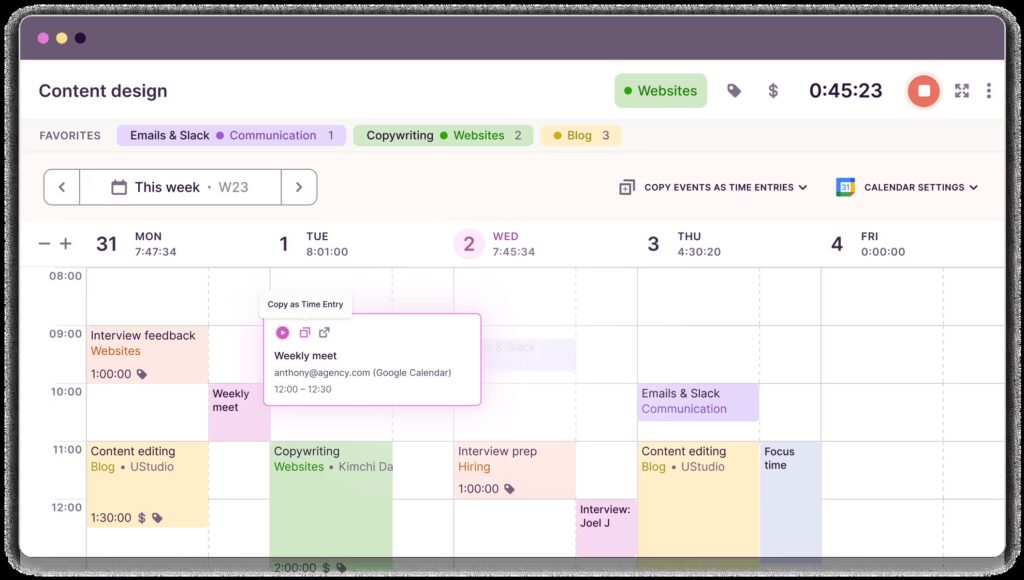
Toggl Track is known for its minimalist design and exceptional ease of use. It emphasizes fast and frictionless time tracking across web, desktop, and mobile platforms. What sets Toggl apart is its flexibility: users can track time in real-time with one click, fill in hours manually, or use its automated tracking features. It’s ideal for users who bill by the hour or manage multiple clients and projects.
Toggl supports Pomodoro timers for focused work sessions, idle detection to avoid false logs, and offline mode to ensure time is captured without internet. Its tagging system and client categorization make it easy to organize and retrieve data for specific projects.
Pros:
Real-time and manual tracking modes with excellent flexibility.
Beautiful, visual dashboards and reports exportable in various formats.
More than 100 integrations, including QuickBooks, Trello, Slack, and Google Calendar.
Streamlined UI loved by designers, developers, and freelancers alike.
Cons:
Does not support scheduling, payroll, or workforce management.
Missing advanced features like GPS tracking, biometric clock-ins, or shift planning.
Less suited for larger teams or field-based organizations.
Clockify
Best for: Budget-conscious teams, startups, agencies, and remote teams needing comprehensive tools without high costs.
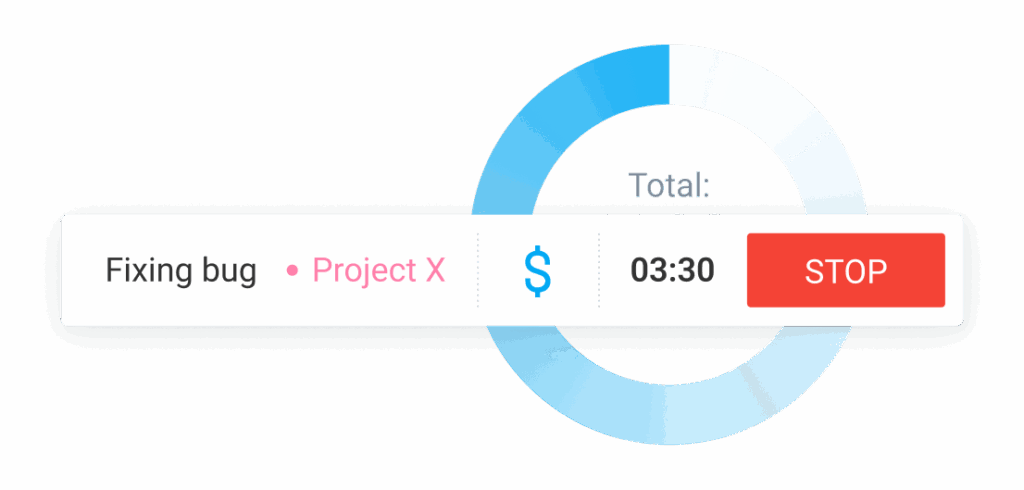
Clockify offers one of the most feature-rich free tiers on the market, with unlimited users, projects, and tracking data. Its versatility makes it suitable for small businesses and larger teams alike. Employees can track time via mobile apps, desktop programs, browser extensions, or dedicated kiosk modes, ensuring compatibility across different work environments.
Clockify supports optional location tracking, screenshot monitoring, and even activity rates, making it excellent for remote team accountability. Its reporting system is robust, with filters, billable hour breakdowns, and CSV export functionality. While core scheduling and payroll tools are available only in paid tiers, the free offering remains powerful.
Pros:
Free plan with no user or project limits, ideal for scaling teams.
Includes optional GPS tracking and user screenshots for better oversight.
Strong cross-platform compatibility and time tracking modes.
Visual reporting with tagging and hourly rates.
Cons:
No integrated payroll or scheduling tools unless upgraded.
The interface can feel functional but uninspired.
Mobile app performance may lag compared to competitors.
Buddy Punch
Best for: Field-based teams, healthcare providers, construction crews, and businesses that require secure, verifiable clock-ins.

Buddy Punch is built with mobility and validation in mind. Its standout features include multiple methods of clock-in validation, such as facial recognition, GPS location capture, QR codes, IP address locks, and PIN entries. These tools help prevent buddy punching and ensure accurate attendance data.
For managers, the system offers real-time visibility into team locations and activities. You can track hours worked, break durations, overtime, and time-off requests, all in a centralized dashboard. Integrations with payroll systems like QuickBooks, ADP, and Paychex ensure that recorded time can be easily processed.
Pros:
Rich verification tools including facial recognition and GPS tagging.
Real-time alerts for overtime, missed punches, and shift limits.
Customizable rules and permissions for different departments or job types.
Highly rated for support and onboarding.
Cons:
Requires an internet connection to function—no offline mode.
The interface is feature-rich but can be slow or complex to navigate on mobile.
Lacks robust analytics or project tracking capabilities.
Connecteam
Best for: Deskless workforces, retail teams, hospitality staff, security personnel, and businesses needing broad operational support.
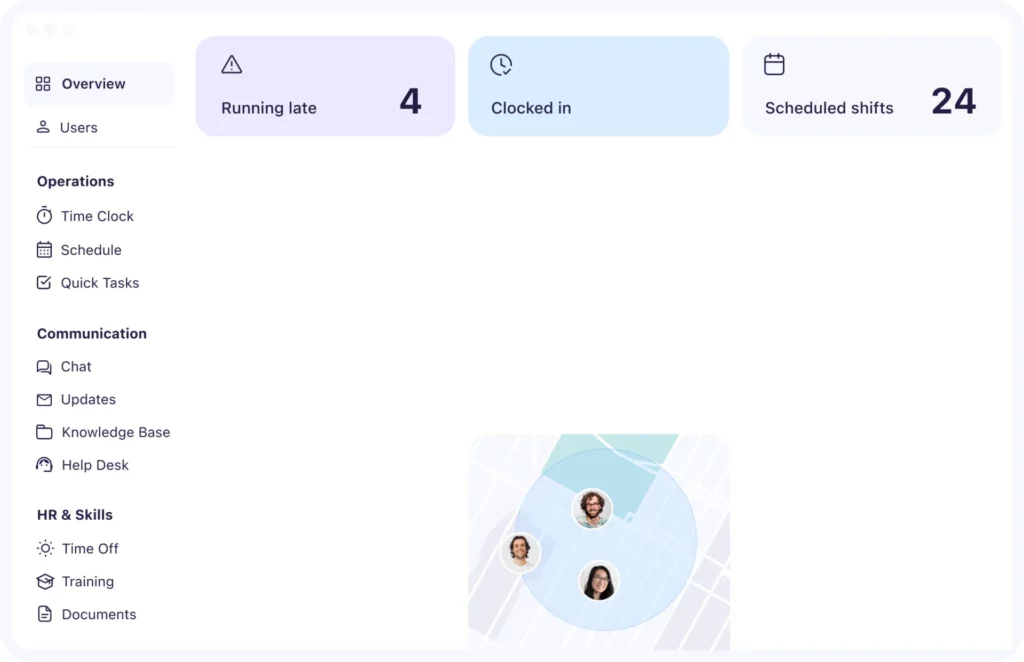
Connecteam is a mobile-first platform designed for companies with remote, mobile, or field-based employees. Beyond just tracking time, it provides tools for scheduling, communication, training, task management, and digital forms. The time clock features include GPS verification, geofencing, automatic reminders, and PTO tracking.
This all-in-one approach helps centralize operations, from checking in for a shift to completing a checklist or communicating with managers. The app also includes shift swaps, chat channels, announcements, and safety protocols, making it an operations hub for non-desk teams.
Pros:
Broad functionality beyond time tracking: HR tools, training, chat, and more.
GPS clock-ins and geofencing improve attendance reliability.
Intuitive interface with high mobile app ratings.
Free tier for up to 10 users with core features included.
Cons:
Premium features (e.g., breadcrumb tracking, advanced compliance tools) are costly.
Pricing model can be confusing and quickly scale up for larger teams.
Some learning curve due to the platform’s extensive capabilities.
Harvest
Best for: Agencies, law firms, consulting firms, and teams that bill clients based on tracked time.
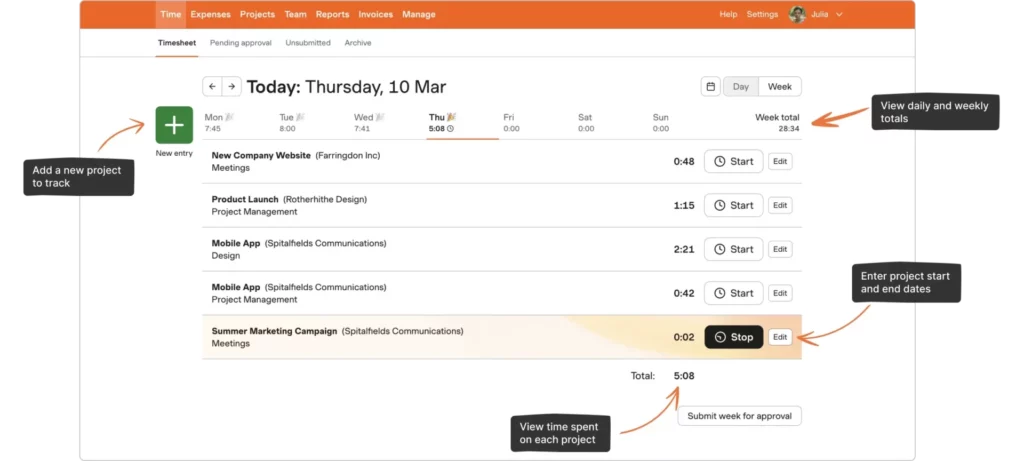
Harvest is focused on turning time into money. It allows teams to track hours with ease, generate visual overviews of time spent across projects, and instantly convert tracked time into invoices. It supports client and project billing, making it ideal for organizations that need clean, professional invoicing and detailed insights into billable vs. non-billable time.
Harvest’s integrations are impressive, it syncs with Trello, QuickBooks, Stripe, PayPal, and Slack, among others. Time entries can be started from calendar tools or within project management platforms. Though it doesn’t offer scheduling, GPS, or biometric tools, it excels in time-based billing and financial visibility.
Pros:
Intuitive UI and one-click timers for easy adoption.
Strong project management and client invoicing capabilities.
Visual time dashboards help manage profitability and project scope.
Integrations with popular finance and task platforms.
Cons:
No free plan (beyond two projects) and charges per seat.
Not built for field teams or companies needing attendance validation.
Doesn’t include scheduling or biometric/GPS tools.
Time Clock App: Key Features Checklist
| Question | Answer |
|---|---|
| What is a mobile time off tracker, and how does it work? | A mobile time off tracker is an app that allows employees to request, manage, and monitor their paid time off (PTO), vacation days, and sick leave directly from their smartphones. It enables managers to approve or reject requests, view team calendars, and ensure adequate staffing all in real time. Apps like Day Off offer a simple, user-friendly experience for both employees and HR teams, available on iOS, Android, and the web. |
| Is a mobile time off tracker suitable for small businesses? | Yes! In fact, small businesses benefit greatly from mobile time off trackers because they reduce the need for manual processes, spreadsheets, or constant back-and-forth communication. With tools like Day Off, even teams with fewer than 10 people can implement a professional leave management system in minutes. |
| Can employees see how many leave days they have left? | Absolutely. A key feature of most mobile time off trackers is real-time visibility into PTO balances. Employees can instantly check how many vacation, sick, or other types of leave days they have remaining — no need to contact HR or wait for approval logs. |
| Do mobile time off trackers support different types of leave? | Yes. You can configure different leave types such as vacation or annual leave, sick leave, maternity/paternity leave, work-from-home (WFH) days, unpaid leave, and personal or mental health days. Custom leave categories can be created based on your company’s specific policy. |
| How secure is the data in a mobile time off tracker? | Security is a top priority for reliable platforms. Reputable apps like Day Off use secure cloud hosting, encrypted data transmission, and role-based access control to protect sensitive information. Only authorized users (e.g., employees, team leads, HR) can access relevant data. |
| What happens if an employee doesn’t have internet access? | Some mobile time off trackers offer offline functionality. This allows users to request leave or view balances offline, then sync the data once internet access is restored. This is especially useful for field teams or employees in low-connectivity areas. |
| Can the app send reminders or alerts for pending approvals? | Yes. Mobile time off trackers send push notifications or in-app alerts when a leave request is submitted, an approval is needed, or a request has been approved or denied. These notifications help managers act quickly and keep everyone informed without manual follow-ups. |
| Can the tracker sync with calendar tools like Google or Outlook? | Most quality apps including Day Off integrate with popular calendar platforms. This means approved leave dates automatically appear in your team’s shared calendar, helping with planning and preventing scheduling conflicts. |
Frequently Asked Questions
Can employees cancel approved leave requests?
In Day Off, employees can edit or delete a leave request before it’s approved. Once the request has been approved, any changes or cancellations will be sent back to the approver to accept the editing or the deleting request, or it can be done by a manager or admin. This helps keep the process transparent and ensures that all adjustments are reviewed properly, preventing confusion or unauthorized changes after approval.
Can leave balances be tracked in hours?
Yes. With Day Off Pro, you can track time off in hours instead of days, which is great for teams that offer half-days, flexible shifts, or hourly leave. You can also set up accrual rules to update weekly, monthly, biweekly, semimonthly, or yearly, so every balance is accurate and perfectly aligned with your company’s policies.
Can policies vary by team or location?
Absolutely. Day Off Pro lets you create customized leave policies for each team, department, or location. You can assign unique holiday calendars, accrual rules, and approval workflows to fit different regions or roles. This flexibility makes it easy for global companies to manage diverse teams while keeping everything organized in one system.
Can I block leave during critical periods?
Yes, you can. Day Off allows admins to set blackout dates, which temporarily block leave requests during important business periods—like product launches, financial audits, or peak customer seasons. This ensures you always have enough staff available and helps your operations run smoothly when coverage is most needed.
Are there notifications for leave events?
Yes. Both employees and managers receive instant notifications through email or the Day Off app for every important update, such as new requests, approvals, denials, or balance changes. This keeps everyone informed in real time, reduces delays, and makes the whole process faster and more transparent.
Conclusion
Adopting the right time clock or PTO tracking app is essential for streamlining workforce management, improving accuracy, and ensuring legal compliance. Whether you need a minimalist tool like Toggl Track, a free powerhouse like Clockify, or robust field support from Buddy Punch or Connecteam, there’s a perfect fit for every team. For PTO-focused tracking, Day Off stands out with its balance of ease, customization, and affordability, especially for remote or growing businesses.
By automating time tracking and leave management, businesses reduce errors, prevent time theft, and empower both employees and managers with clear, accessible data. Choose your tool wisely, train your team, configure your settings, and watch your operational efficiency soar.
